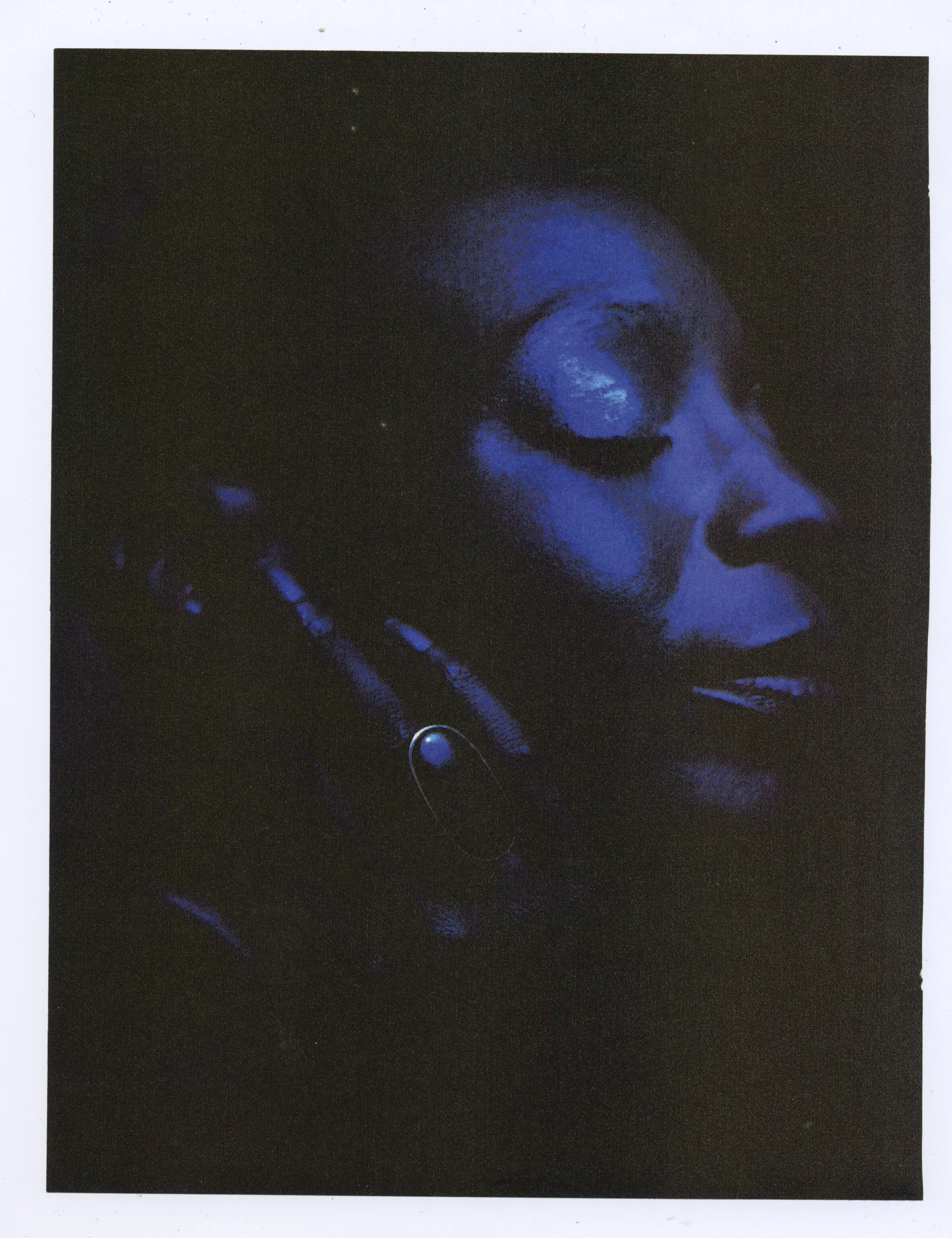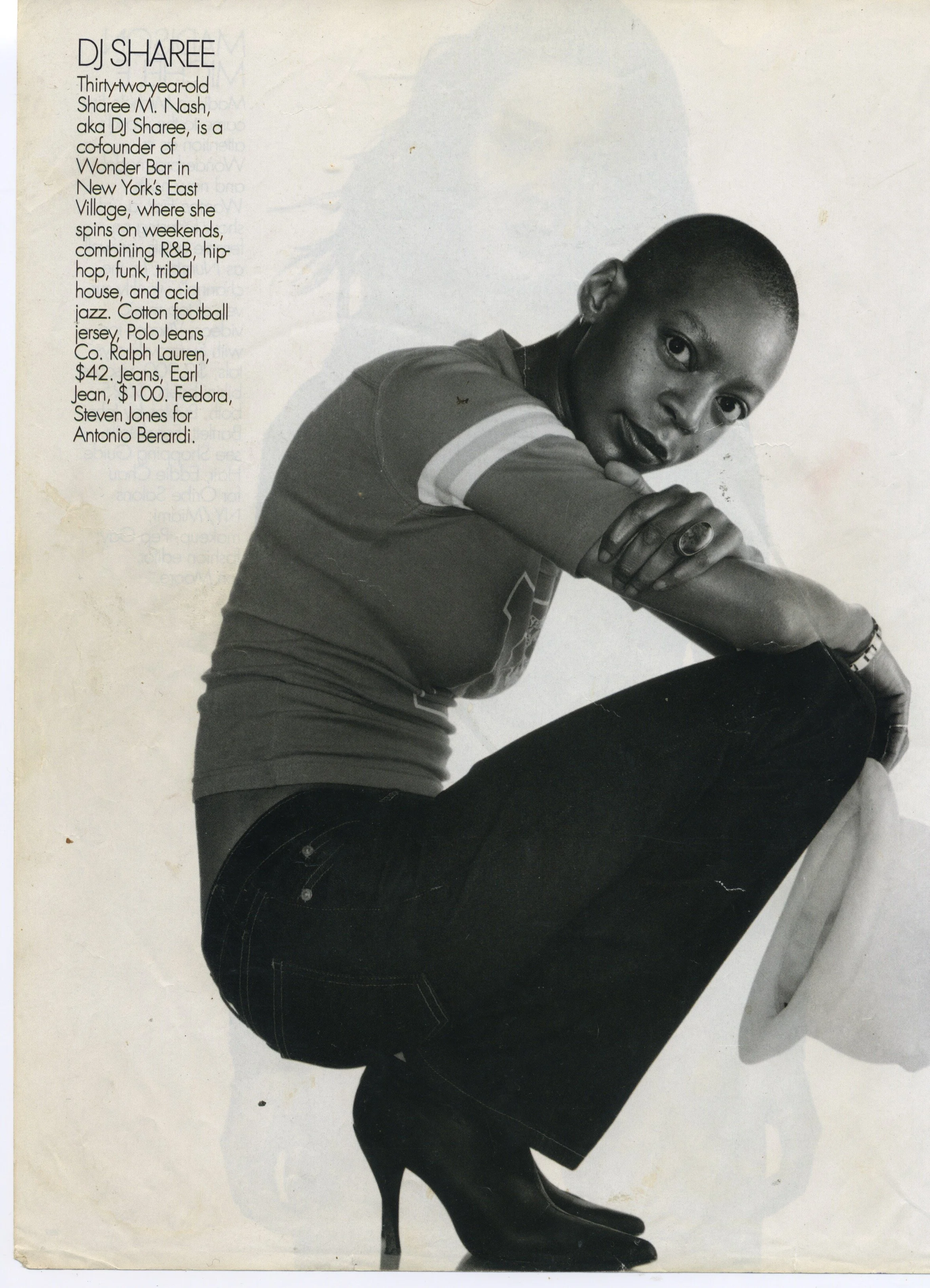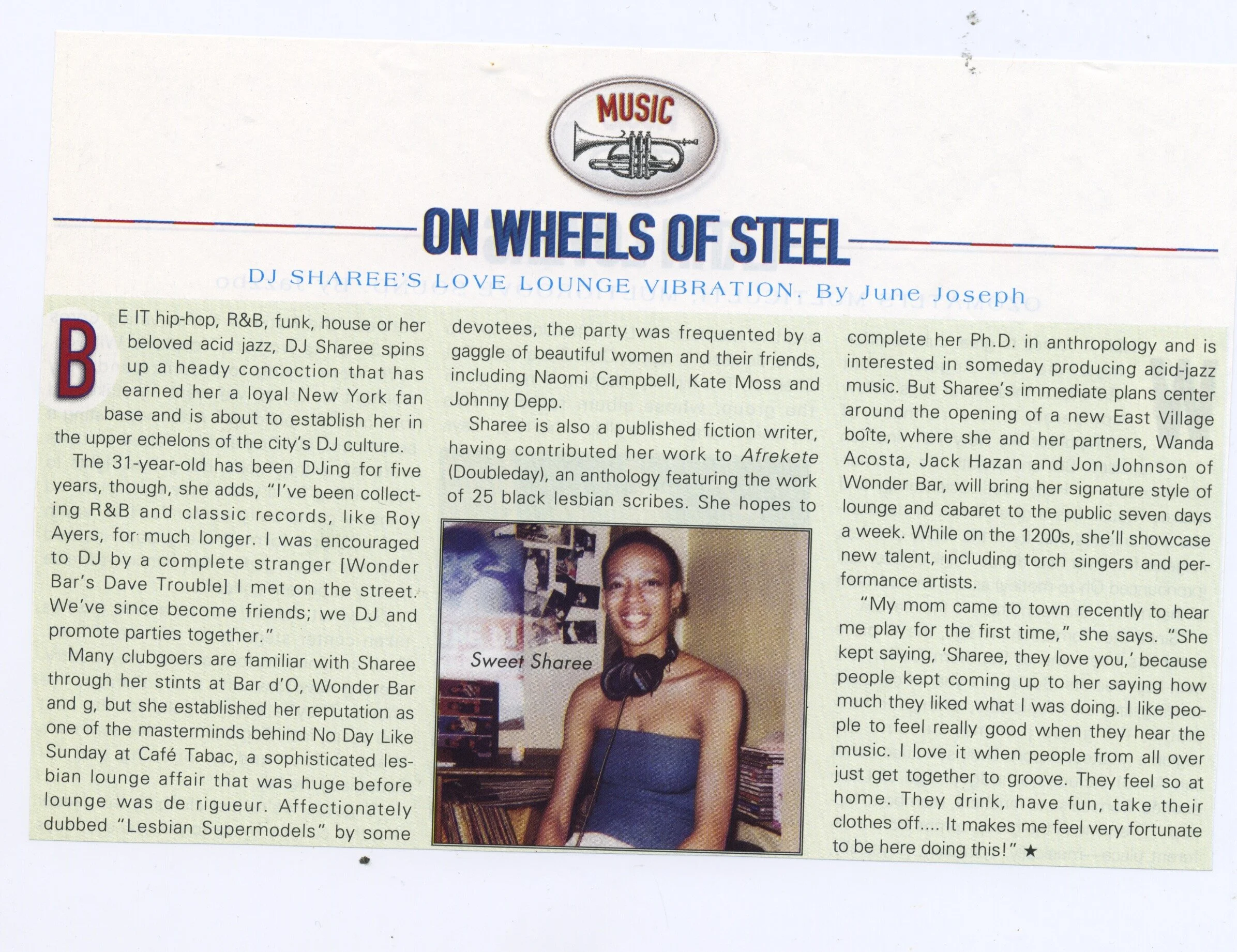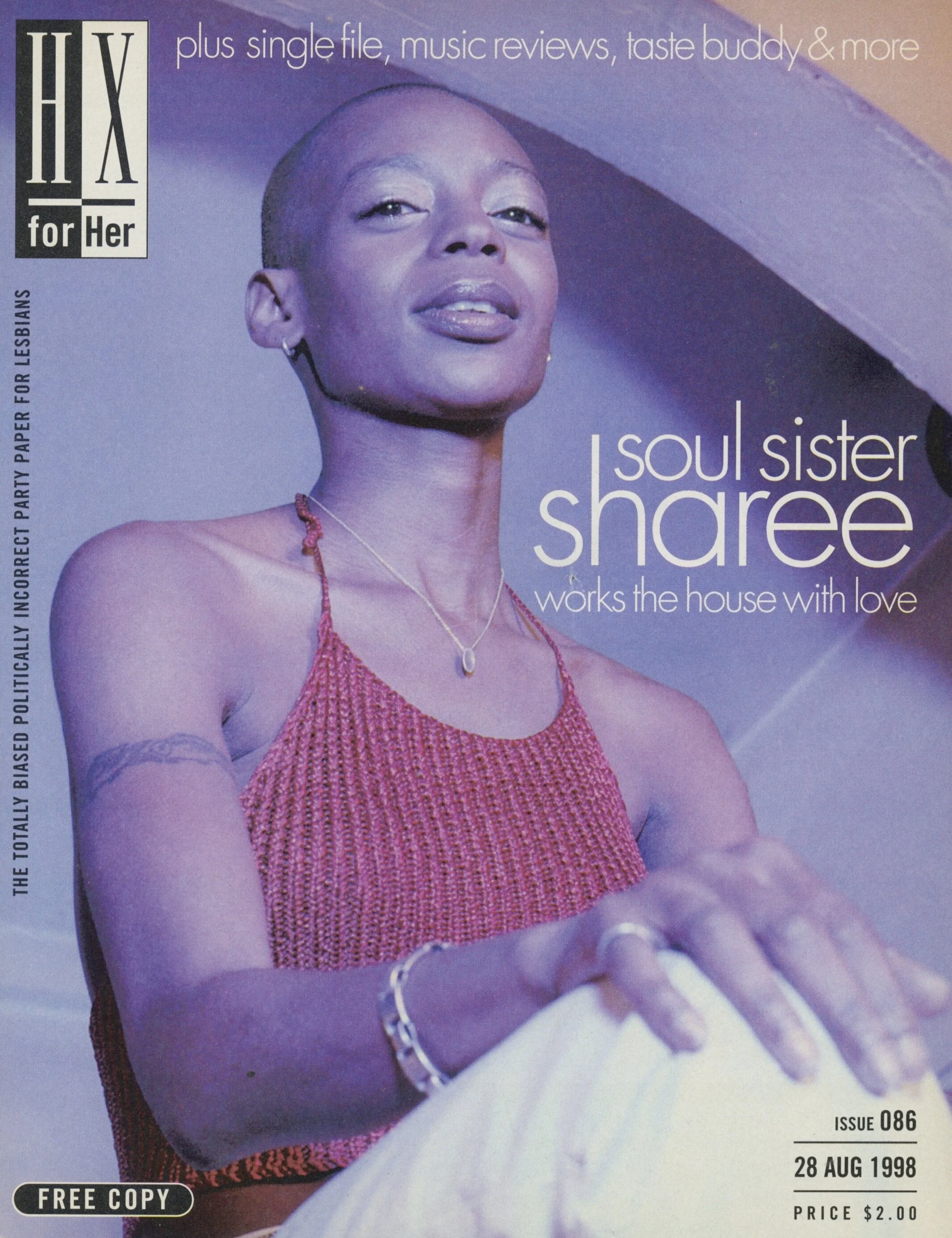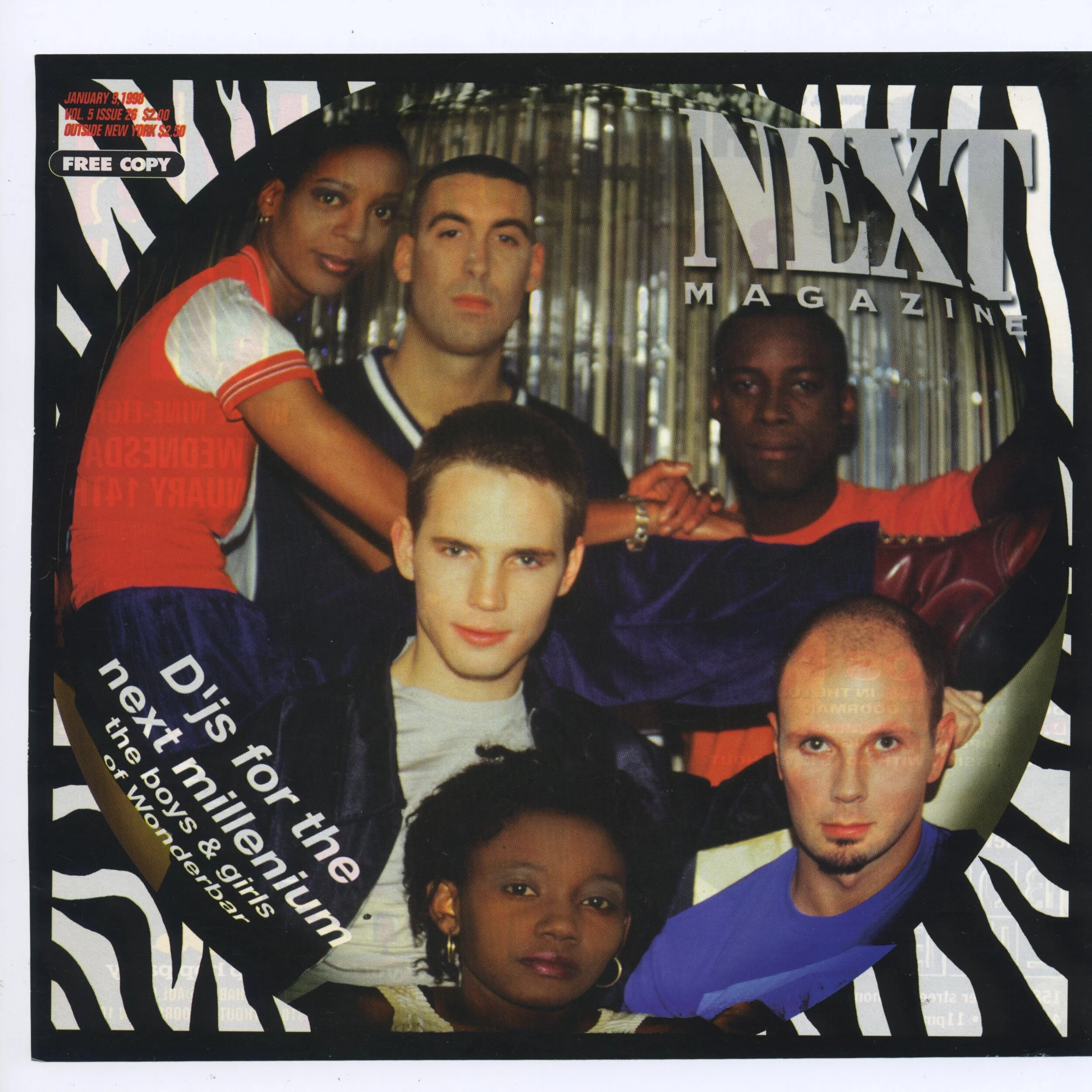Sharee Nash
Sharee Nash is a writer, deejay, and co-founder of iconic parties for queer women and lesbians including Sundays at Café Tabac and Mondays at Bar d’O in the 1990s and early 2000s with fellow nightlife icon Wanda Acosta. Sharee’s extensive knowledge of and passion for music has led her around the globe in search of sounds unheard of in New York City. Her work in nightlife with Wanda ushered in a massive shift in lesbian culture out from the hidden, mafia-owned dive bars into visible and glamorous spaces. Parties such as Sundays at Café Tabac enabled queer women to see one another and to see themselves with respect and adoration. The following conversation was recorded on April 16, 2018 at 4pm at Patisserie Des Ambassades in Harlem, NY.
Gwen Shockey: What was the first lesbian bar or predominantly lesbian space that you ever went to?
Sharee Nash: Hm. I’d have to say it would have been Pandora’s Box. I didn’t come out until I was twenty-two. I moved to New York when I was twenty-one and I thought I’d figure it all out. I was adventurous. I had been living in Germany for a while with my family and I would just go out and find places where women gathered there. I wanted to figure out if I was a lesbian so I figured I’d just go to Pandora’s Box. It was in the West Village and I walked in, looked around, panicked and left! My idea of queer then was a sort of Anais Nin vision and I imagined I’d walk into a room full of women with long, long hair and red lipstick but when I walked into Pandora’s Box I was like: Blimey! It was just sort of typical I guess for a lesbian bar then.
I had been engaged to be married since I was eighteen and I had only ever read about queer lifestyles. It never really crossed my mind that it could be me, I was just reading literature about women and the culture so I had this fantasy in my mind about what lesbians were. I mean, the music in Pandora’s wasn’t sexy to me – it was old school pop. I was just going through a different phase music-wise. So, yeah I mean the music wasn’t romantic, the scenery wasn’t really romantic – I’m a romantic so that whole scene was a little hardcore for me. So, that was the first one! Pandora’s Box was around forever. I liked the idea of the name. I had myself all dolled up for a night out you know? But I ran straight out of there and went into another tiny bar that looked nice and seemed to be owned by a queer person. I met some guys there, some super sweet guys, and they were like, “Oh honey, don’t give up!” (Laughing)
GS: Do you remember what you were wearing when you went out that night?
SN: Probably the same thing I wore everywhere: a pair of jeans, a nice t-shirt. I think it was warm. My uniform is always a pair of jeans and a t-shirt. I’m a tomboy with a bougie mother… so I’m sure I had on a very expensive pair of shoes, a handbag with a tube of lipstick and a pack of Gauloises cigarettes in it.
GS: Was the dynamic pretty butch/femme in Pandora’s Box then?
SN: Yeah! I mean that was my first experience. I eased into it. I found you had to sort of tease through the scene because there were little pockets of different types of people. At the end of the day once I met more lipstick lesbians that became a sort of pocket or scene that I helped create. Actually, when I finally found kind of what I was looking for it was this house party in Brooklyn. This woman who I knew threw these parties for women of color and it was just hot house music and girls half naked, sweating, dancing, gyrating and I thought: Yeah! That’s more like it! It was a private party, special invite. It was called “The Children’s Hour.” So, that was a different dynamic that just felt more comfortable for me. Having a conversation with someone is fine but I like dancing and obviously I like music, I’m a deejay. So, I liked that part a lot you know? It was just different from Pandora’s Box or Henrietta Hudson, I mean there was diversity but a lot of places were just where the white girls went.
Everyone had their own agendas too. Some of the parties were private because a lot of women couldn’t come out. That was one of the things that people really liked about Café Tabac when we started throwing that party. It was upstairs and it was private. You had to know someone to get in so we had people in the limelight, in the celebrity world who couldn’t afford for it to get out that they were hanging out in dyke bars. Even then, in the ‘90s it was sort of hush, hush.
GS: What was your coming out process like?
SN: Well, I realized I wasn’t straight when I fell head over heels for one of the girls in my dorm. Like I said I was engaged to be married. I went to the University of Missouri-Columbia. I didn’t know any other lesbians then but all of my male friends were gay and my cousin is queer. I was hanging out at the gay bars near school with gay boys but I was like: I’m good, I’m heterosexual, I’ve got a man, no problem. Something really hit me though and I started really thinking about. But, man, I was 19 years old engaged to be married and it was crazy! So, I called off my engagement because I felt like I would be a ball and chain at twenty-one years old. So that was that.
Boy bars were great though! If you were the only cute girl in the room all of your drinks were paid for, you were complimented, you were fanned, they carried you around, your feet never touched the floor – they were just great. There was so much trauma in that community so there was a lot of love brought to those spaces. So, appreciated all of that and so when I finally came out it was fine. Of course, my mom’s reaction was to tell me she really wanted grandchildren and I was like: I haven’t given up my womb! I mean even if I were heterosexual I’m not sure I’d want kids because I don’t really feel that maternal thing. All together I have six aunts and for a while I was the only child because I’m the oldest. When I came out to one of my aunts she told me she understood and she told me some stories about experiences she had when she was younger. She had fun! I think a lot of people deprive themselves of experiences if they aren’t willing to understand their bodies and needs for other forms of comfort and familiarity. I mean it’s just like you will never understand the black experience if you aren’t black, you will never know what it feels like to move through the world as a black person unless you are. It’s like the experience of being a woman too it’s really different. You have to have an open mind to see yourself as something other than how people perceive you because of the color of your skin or your gender. You just have to find places with like-minded people.
I always searched for the alternative in everything anyway so at the end of the day I had the crazy fortune of meeting Wanda [Acosta]. I met her at this place in Chelsea called Lola’s. It was owned by Alexander Smalls who was just a tremendous chef and happened to be southern. They would have live music, dancing, salsa night and so my girlfriend at the time was the hostess for the restaurant. It was swanky and upscale everybody would come after work in business attire but it was straight, totally straight, I was there because my girlfriend was the hostess. My girlfriend was a model and all of her friends were models too so I would just be in there with all the pretty women. I was there one night sitting at the bar while my girlfriend worked it, having my martini and, this sounds corny, but I was reading Orlando – I’m a walking cliché! (Laughing) Wanda rolled up and asked me if the seat next to me was taken and I said no so she sat down and was looking at my book and I was wondering if she was queer too! She could have just as easily not have been!
GS: I need to start carrying lesbian literature around!
SN: (Laughing) It used to work! You can’t tell anymore because everyone’s on their iPhone or Kindle! So, Wanda and I started talking and realized we were both queer and she asked me what brought me to that bar and I told her I liked my martini in a proper glass and I don’t like peanuts on the floor! Stemming from that first meeting we started talking about creating a party for chic lesbians – a space that we wanted, that we ourselves would go to! And that’s how it started! As simple as that. We both liked to get dressed up and feel fabulous and we liked to be wooed and read poetry you know? It became about creating the space that was ideal and alternative and clearly it was! I mean, there were parties before that like Cave Canem on 1st Avenue which they just closed recently. Cave Canem was a restaurant with a little cellar that you went down into. It was a private party for queer women to go and be outrageous and unapologetic.
GS: Where do you think this desire for different modes of presence as lesbian came from? Was it a desire to break down the butch/femme dynamic?
SN: I don’t think we’ll ever break that dynamic. Listen, I was out as a lesbian. I was published in a lesbian anthology. It was ok for me to be out because I was always an artist. You can choose not to hire me or read my writing but being out never threatened the work I chose to do. I do think for other women there was a need to keep their sexuality separate from their professional lives. I think privacy is just a value for some people. Our parties were basically that. They were private parties. Bar d’O was private. Once we opened WonderBar and Starlight everyone was welcome. Do you remember the scene in the L Word where Bette Porter comes to New York and goes to a lesbian bar? That was Starlight!
GS: It really seems like the parties you and Wanda threw and the bars you ran really allowed women to find self-worth as individuals and as a community. To be able to escape the dive bar, come together in a beautiful, thoughtful environment seemed so important.
SN: Yeah and something that was important to us was that it wasn’t always about going out every night and cruising and picking up chicks, rather being around creative people. I’m a writer – I like to talk to poets, readers of books, healers and other writers and music is my life so meeting someone who would notice what was playing rather than just standing there drinking their beer was amazing. On Sunday nights it was a huge dinner party with community tables and people would sit and hop from one table to the next – there was food, music, drinks and sexy lighting. There would be a muralist sitting next to, say, Sandra Bernhard or a drag king, gallery owner, photographer, comedian, fucking tight-rope walker sitting next to Patricia Field so we just had all these different types of people together. We had it all! The idea for us was just queer women sharing their passion for all things queer and cultured and each other as women in our different experiences…together.
GS: Could you tell me a little bit about how you began deejaying? Did it start at Sundays at Café Tabac or were you deejaying before?
SN: Deejaying for the public was again one of those serendipitous moments (I’m a bit of an agoraphobe) I loved making compilations since I was a kid. When I got my first job as a babysitter, I used that money to buy records and turntables. So, when I moved to New York from Germany and got settled, I set up my deejay booth under my loft bed in a tiny studio apartment in the East Village. An ex introduced me to this super cool guy new to NYC from Oakland and he saw my setup and flipped through my collection of vinyl and encouraged me to basically Shine My Light! *Much Love to Disco Dave*!
I would make mixed tapes for Sundays at Café Tabac. This is how long ago it was. Every week I would make about four mixed tapes for the night. So, I ended up with a huge collection of mixed tapes. And I was actually spinning records at Bar d’O. I was doing this, then I met these women who were doing huge parties with like a thousand women on Friday nights in a warehouse space. They had three floors. They wanted everything. First floor was house music with pole dancers and strippers, the second floor was Latina, and then the top floor was a lounge where I was spinning soul and jazz and stuff. That was huge because it was one of the biggest lesbian parties at the time. I was doing some major things and then Wanda and I started Bar’d O on Monday nights. People thought we were out of our minds and that no one would show up on a Monday night. We were like: They will. You’ll see. Bar d’ O was really intimate. The idea was to add an element of burlesque…not a strip-show… a strip-tease in a triptych. Exotic dancers, drag kings, contortionists, fire-eaters! Lots of celebrities showed up there because they knew they had anonymity. We carried on at Bar d’O for years. Another one of my favorite experiences was working with Julie Tolentino, mastermind behind the Clit Club! We all have her to thank!
GS: I feel like the role of the deejay at lesbian parties that I’ve been to is this mythic type person. Not only are you controlling the energy of the crowd in a way but you’re also there to be seen, there is such almost desire between the audience and the deejay. Did you feel that?
SN: I mean for me, there was always a frame for it. I don’t know if you’ve seen pictures of WonderBar but our partner John built this deejay booth, he’s a set designer. It was up on a platform in the back of the bar when you walked in. There was this huge oval almost like an eye and he created lighting so it was basically a stage. If you’re an aesthetic snob every little detail has to have some sort of connection to art or nature – you have to be able to connect the dots. Funnily enough I’m the most introverted person. I don’t like to speak publicly, I don’t like having my picture taken, if you look at me for too long I’ll run up a tree you know? There was something different for me about deejaying. It was my way of communicating. Being a part of the community, I could party with everyone but not be on the floor with everyone. We would try to make sure that the booth situation was part of it all but not in the middle. There was a lot of thought put into that. One night I was hanging out with some friends after hours and there was this guy there and one of my friends was like, “Sharee’s a deejay!” and he was like, “Oh never heard of her”… my friend told him he had to go and “See me”! and I thought it was really interesting that she said he had to see me…because it was a visual experience. It’s a really visual experience in that the crowd is loud, that he could come in a watch me spin for hours and jam to the music. I guess I lose myself you know? When everyone’s out there dancing and I’m standing there with my cup of tea, I pull off all my clothes and I’m just like in it. (Laughs) It was so fun for me. I’d have a sort of call and response. I would kind of know what would happen like, they’re going to lose their minds in three, two, one! It’s the most amazing feeling. I stopped. I was deejaying at a wine bar up here in Harlem. It was nice because people really listened. But after a while people started requesting songs they knew and I would say: No! I’m the deejay! I’m going to play something you don’t know so you can experience something new! That was a lot of what I heard from people over the years – that they’d come hear me spin and only recognize two or three songs in a night and they loved it! It was fantastic. Total opposite today.
GS: Do you think it has something to do with technology? I mean people have their phones with them all the time, they’re like, “Play this song!”
SN: It was not like that. It totally flipped. It used to be so amazing. It was global too. So much of my music came from overseas. It was nothing you would hear on the radio. Even the radio is different now. Back in the day when we were listening to the radio there was a loop, yeah, but they would loop in something new. It was a lot more soulful. There were lyrics. I do like some trap music but most sounds like they just created a dumpster fire and called it music and sold it to everybody as “trending”. I had my European collections and friends would come over from London and come with new vinyl. This whole idea of being connected globally... I mean people just don’t understand! Norwegians just killed at house music! Bringing it here was so fun and challenging. I would get so excited for certain nights when I could say like: Fresh from London, some new vinyl! The people would be so into it. It’s just a different attitude. You can’t even have an opinion about anything anymore. People are having fist fights over Beyonce and I’m like: Stay mad! Because Beyonce is doing Beyonce better than anyone else could ever do so whatever you’re mad about it’s your mad! You can’t even write a fucking post on social media without people saying it’s not politically correct. So yeah, the whole dynamic just changed and it no longer interested me to try to share something new with people who thought they knew it all.
GS: that makes me sad you know? That lack of curiosity, that lack of wanting to learn… Do you think it’s changed the way people party now?
SN: People are either on the offensive or the defensive…like, everybody in the room is either the hostess or the deejay! Those have been my experiences. If I’m going to go out and have a good time now I go to Europe. (Laughing)
I retired this year from my job at Columbia University in the Graduate History Department. I had to hang that up – I did it for sixteen years and I just couldn’t do it anymore. I’m an English teacher and that’s what I’m trained to do. So, I retired from university life and I’m writing a series of different things. I write poetry, short fiction… I guess I would describe my writing as sci-fi erotica.
GS: Does music affect your writing in any way?
SN: Oh yeah! Just yesterday I started writing a series in response to ten songs that had an impact on my life. I usually don’t do these things because it’s hard to pick a finite number of things that have influenced me. I’m on day nine now but I was thinking should I choose hip hop, soul, house? It just so happened that I picked the first album off the top of my head, which was this acid, jazz, soul album that was really brilliant and from that I remembered that I had already started a story from a long time ago just inspired by one of the songs. The chapters ended up being based on the rhythm of a song – a lot of Sade in there. The long answer to your question is yes. I don’t know what came first, music or writing. I’ve been writing since I was a child and it’s all about rhythm.
GS: Do you still go dancing?
SN: The last time I danced was on my birthday. The first girl I fell head over heels for reconnected with me a couple years ago. I was home in St. Louis visiting with my mother and she took me out for my birthday and the DJ played “No diggity, I like the way you work it…” and it was such a great time dancing in my hometown…being older…still feeling none the bit wiser in the “Great Scheme”…but that was the extent of my dancing recently. No dancing in my bra like the good old days! No tumbling off of tables in my stilettos… I’m not kidding. I still have the scars to prove it! I’m not saying we had more fun than kids now but Wanda and I, twenty something years ago, were in our late twenties and there were a lot of people in our circle who were famous and loved to dress up and it was just a different time in New York. Really different from now. I’m older now and I just want to cheer from the sidelines…leave it to you crowd to have the fun and keep the party alive!
GS: Any juicy stories you want to close out with Sharee?
SN: How about me distracting some girl by showing her my tits while her girlfriend was sitting in a booth with another girl on her lap with her tongue down her throat! There was tons of drama! But we didn’t have it splashed all over viral social media like we have today! PrideNYC was just beautiful madness. You’d get a fresh batch of women in from out of town…lots of love and trouble-making! It could get pretty debauched!
GS: Sharee, you’re amazing. This was amazing. Thank you so much for sharing these stories with me.
